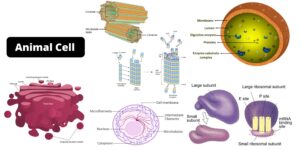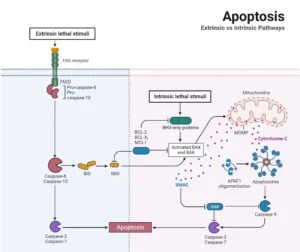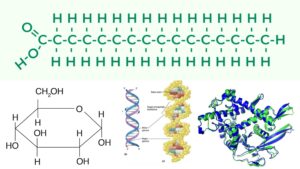Fertilization Definition
- The term “fertilisation” (from the Latin fertilis, which means “to bear”) refers to the joining of the cytoplasm and pronuclei of the male and female gametes.
- The most frequent mechanism for creating diploid zygotes in sexually reproducing Metazoa and Metaphyta species is fertilisation.
- The haploid female gamete (ovum or egg), which carries the genetic information of the female parent, combines with the haploid male gamete (spermatazoa or pollen), which carries the paternal genetic information, to generate a diploid zygote during the fertilisation process.
- The zygote eventually gives rise to a diploid multicellular creature through numerous organised and repetitive mitotic divisions.
External and Internal Fertilization
- In aquatic media, such as salt water, fresh water, or the intra-somatic (body) fluid of the mother, fertilisation always takes place.
- Internal fertilisation is the word used to describe fertilisation that takes place inside an organism’s body as opposed to external fertilisation, which occurs outside the body of the organism.
- While internal fertilisation only happens in creatures with specific sex organs for receiving and delivering the sperms, such as reptiles, birds, mammals, and angiosperms, external fertilisation is prevalent in a variety of invertebrates and chordates.
Fertilizin and Antifertilizin
Fertilizin
- Fertilization is a fairly specific procedure. Sperms of a specific species fertilise the ova of that species.
- This type of specialisation of male and female gametes is of the utmost importance to biology and is achieved with the use of certain chemical substances.
- The egg is revealed to contain a chemical compound known as fertilizin.
- Depending on the species, fertilizin is a glycoprotein consisting of various amino acids and monosaccharides (glucose, fucose, fructose, and galactose).
- Fertilin has a molecular weight of 300,000 and contains big molecules.
Antifertilizin
- The outermost layer of sperm contains an additional protein known as antifertilizer.
- Antifertilizin is a protein consisting of amino acids with an acidic pH. It contains molecules with a molecular weight of approximately 10,000.
- The eggs’ fertilizins are designed to attract sperm containing a specific sort of antifertilizer.
- Egg fertilizin of any species responds effectively with sperm antifertilizer of the same species.
- It has also been reported that fertilizin in egg-water attracts sperms of the same species, causing them to adhere together in large numbers.
- This type of sperm mutual adherence is referred to as agglutination.
Process of Fertilization
The two sequential steps of the fertilisation process are as follows: 1. The egg’s activation; 2. The amphimixis.
1. Activation of the Egg
The process of activation of eggs is completed in following stages :
(i) Movement of the sperm towards the egg
- Randomly, sperms in the exterior or internal fluid media surrounding the egg swim towards the egg. They accidentally crash with the egg.
- Chances of sperms colliding with the egg occur frequently in nature, and only the vast quantity of sperms and enoromously large size of the egg keep these collisions from being fruitless.
- Fertilins and antifertilins become active following the accidental interaction of sperm and eggs. Typically, the egg fertilizin is found in the jelly around the egg.
- It slowly dissolves in the egg’s surrounding water to generate the so-called egg water.
(ii) Activation of the sperm
- When sperm with a certain antifertilizer comes into touch with the egg water of its own species, the sperm’s acrosome undergoes dramatic alterations.
- The peripheral region of the sperm acrosome disintegrates, and its lysins are expelled and dissolve in water.
- The core component of the acrosome elongates and forms the acrosomal filament, a 1 to 75m long, thin tube.
- The hard tube that protrudes from the sperm head called the acrosomal filament. When sperm possesses an acrosomal filament, it is considered to be activated for egg penetration.
- As a result of the dissolving activity of sperm lysins, acrosomal filaments penetrate the egg jelly and vitelline membrane when active sperms reach the egg.
- As soon as the tip of the acrosomal filament contacts the egg membrane (plasma membrane), a number of crucial morphological and physiological changes occur in the egg.
(iii) The activation of egg insemination
- At the point of contact between the acrosomal filament and the egg surface, ooplasm protrudes in the shape of a cone, known as the fertilisation cone.
- The fertility cone can have a conical, cylindrical, or irregular shape. When the form of the fertilisation cone is uneven, several pseudopodia-like ooplasm processes are present.
- Plasma membrane and hyaline cytoplasm make up the fertilisation cone.
- The fertilisation cone envelops the sperm, which is surrounded by hyaline cytoplasm and moves inwards.
- Insemination refers to the process of sperm penetrating an egg.
- Immediately upon fertilisation, a thin membrane called the fertilisation membrane forms around the egg’s plasma membrane.
- The fertilisation membrane stops further sperm from entering the egg.
2. Amphimixis
- During insemination, the sperm may enter the egg in its entirety, as in mammals, or its tail may remain outside the egg, as in echinoderms.
- In certain instances, like as in Nereis, the sperm’s tail and middle section remain outside the egg, while only the head and centrosome enter.
- The sperm nucleus is referred to as the male pronucleus. By taking water from the surrounding ooplasm, the male pronucleus swells and becomes vesicular.
- The male pronucleus’ densely packed chromatin material becomes coarsely granular.
- Aster rays surround the sperm centriole, which is encircled by the centrosome and microtubules.
- The male pronucleus and the centriole travel in the direction of the egg pronucleus. In the case of sea urchins and vertebrates, the two pronuclei (male and female) approach one another and come into intimate contact with one another.
- At the point of contact, the nuclear envelope is ruptured and the nuclear contents of both pronuclei are mixed.
- Thus, the endoplasmic reticulum creates a zygote nucleus by forming a new nuclear envelope around the two pronuclei.
- This form of fusion of two pronuclei is not observed in Ascaris, annelids, and mollusks.
- In these organisms, microtubules of the ooplasm form the achromatic spindle, male and female pronuclei approach one another, and their nuclear envelopes are destroyed.
- On the equator of the achromatic figure, homologous paternal and maternal chromosomes are aligned, and the first cleavage (mitotic) division of the egg occurs.
- Following this division, the nuclear envelope is produced surrounding the daughter nuclei’s chromosomes.
Post-Fertilization Changes in the Egg
After fertilisation, the egg undergoes the following changes:
- the zygote becomes prepared for cleavage and embryo development.
- The zygote’s oxygen consumption grows dramatically.
- The zygote’s metabolic rate increases dramatically. For example, the number of amino acids and the permeability of the egg’s plasma membrane increase the egg’s volume and limit the exchange of phosphate and sodium ions between the zygote and the surrounding medium. In addition, calcium ions begin to diffuse from the egg and the hydrolyzing activity of the proteolytic enzymes rise.
- The protein production begins.
Kinds of Fertilization
In the organisms following types of fertilization occur :
1. Monospermic fertilization
- This type of fertilisation is known as monospermic fertilisation and occurs in the vast majority of animal species.
- It is frequent for coelenterates, annelids, echinoderms, bony fishes, frogs, and mammals to undergo monospermic fertilisation.
2. Polyspermic fertilization
When many sperms fertilise an egg, the process is known as polyspermic fertilisation. It can be of two varieties:
- Polyspermy that is pathologic Under some abnormal conditions, when several sperms enter an egg of monospermic type, the phenomenon is referred to as pathological polyspermy. This type of egg does not continue to grow and dies quickly.
- Polyspermy physiological. Typically, polyspermic fertilisation occurs in animals with big yolky eggs, including mollusks, selachians, urodels, reptiles, and birds. The term for this type of polyspermic fertilisation is physiological polyspermy. In some instances, numerous sperms penetrate the egg, but only one sperm’s pronucleus joins with the egg’s, and the remaining sperms degenerate quickly. These eggs are viable and will continue to develop.
3. Polyandry
- Polyandry is the union of two male pronuclei with a female pronucleus, as in the case of man and rat.
4. Polygamy
- Polygamy occurs when two egg pronuclei fuse with a single male pronucleus, as in sea urchins, polychaete worms, urodels, and rabbits.
5. Gynogenesis
- In planarians and nematodes, this occurs when just sperm activates the egg but its pronucleus does not connect with the egg pronucleus.
Fertilization in Plants
- A plant is a gift from nature because it provides us with food, oxygen, shelter, clothing, etc. They are also referred to as primary or universal producers.
- Plants, like all other forms of life, respire, grow, develop, excrete, and reproduce. All plants reproduce by fertilisation.
- In 1884, Ralph B. Strasburger identified the process of fertilisation in blooming plants. Let’s take a little chat about fertilisation.
- Fertilization is the third phase of sexual reproduction in plants, occurring after pollination and germination.
- Fertilization is the fusing of male gametes (pollen) with female gametes (ovum) to produce a diploid zygote.
- It is a physicochemical process that occurs after the carpel has been pollinated. The entirety of this process occurs within the zygote as it develops into a seed.
- As the reproductive structures of angiosperms, flowers play a vital part in the fertilisation process (flowering plants).
- The process of fertilisation in plants occurs when haploid gametes combine to form a diploid zygote.
- In the process of fertilisation, pollinators (honey bees, birds, bats, butterflies, and flower beetles) transfer male gametes to the female reproductive organs, resulting in the creation of an embryo in a seed.
Fertilization Process
- In flowers, after pollination of the carpel, the pollen grain germinates and grows into the style, creating a pathway for the pollen grain to move to the ovary.
- Through the micropyle, the pollen tube enters the ovule and bursts into the embryo sac.
- Here, the male nucleus fuses with the egg nucleus inside the ovule to form a diploid zygote, which later develops into a fruit.
Types of Fertilization
The entry of the pollen tube into the ovule primarily determines the classification of the three types of fertilisation processes.
Porogamy
- It is the typical method of fertilisation employed by all angiosperms or flowering plants.
- The pollen tube enters the ovule via the micropyle in this method of fertilisation.
Chalazogamy
- This method of fertilisation is utilised on all Casuarina species.
- Under these circumstances, the pollen tube enters the ovule via the pollen tube.
Mesogamy
- This method of fertilisation occurs in all Cucurbit plants, including pumpkins, ridge gourds, bitter gourds, and other gourd plants.
- In this method of fertilisation, the pollen tube enters the ovule via its central portion or its integuments.
Double Fertilization
- Double fertilisation is a type of fertilisation that occurs when a female gametophyte fuses with two male gametes.
- One sperm cell merges with the egg-producing zygote, while the other fuses with the two polar nuclei to form the endosperm.
- Each and every angiosperm plant undergoes a dual fertilisation process.
Fertilization in Humans
- Fertilization in humans is the fusing of male and female gametes, which enables the birth of a new organism.
- Fertilization is the natural process of life, which involves the union of male and female gametes, resulting in the development of a zygote. In humans, fertilisation takes place within the fallopian tube.
- During coitus, thousands of sperm-containing spermatozoa are introduced into the female vagina.
- The sperms migrate toward the uterus and reach the fallopian tube opening. A small number of sperm will reach the fallopian tube’s entrance.
- The secondary oocyte is released from the mature Grafian follicle of the ovary and enters the fallopian tube, where it is fertilised within twenty-four hours. The ovary then releases the secondary oocyte.
- Despite being surrounded by several sperm, a single sperm fertilises the oocyte. Sperm penetrates the secondary oocyte and completes meiosis during meiosis-II. Following this, the secondary oocyte is referred to as the egg.
- Sperm and egg exhibit vitality for a limited amount of time. Sperm is viable in the female reproductive system for 48 to 72 hours, whereas the egg can be fertilised and released 24 hours after fertilisation.
Steps of Fertilization in Humans
Fertilization in humans occurs at multiple stages including both chemical and physical processes. The many stages of human fertilisation are described below:
Acrosomal Reaction
- The incapacitation of sperm results in acrosomal reactions and the release of compounds known as sperm lysins from the acrosome.
- As a result of acrosomal processes, the plasma membrane of the secondary oocyte and the sperm become united, allowing the sperm’s contents to enter.
- When the plasma membrane of the sperm connects with the plasma membrane of the secondary oocyte, the oocyte’s plasma membrane depolarizes. This eliminates polygamy.
- Important roles are played by calcium ions in the acrosomal process. Optimal pH, temperature, and calcium and magnesium concentrations are needed for acrosomal processes.
Cortical Reaction
- Soon after plasma membrane fusion, the oocyte exhibits cerebral responses.
- Under the plasma membrane of the oocyte are cortical granules, which fuse with the plasma membrane and release cortical enzymes between the zona pellucida and plasma membrane.
- Cortical enzymes, which prevent polyspermy, stiffen the zona pellucida.
Sperm Entry
- The secondary oocyte forms a protrusion known as the cone of reception at the moment of sperm contact.
- This reception cone receives the sperm.
Karyogamy
- The secondary oocyte completes the stalled second meiotic division following sperm entrance. This results in the formation of a haploid egg and a second polar body.
- Male pronucleus is the head of the sperm carrying the nucleus that detaches from the rest of the sperm.
- The tail and second polar body begin to deteriorate. The ovum’s nucleus is known as the female pronucleus.
- Male and female pronuclei merge and degenerate their nuclear membranes.
- Karyogamy refers to the chromosomal fusion of male and female gametes.
- The fertilised ovum is now known as a zygote.
Activation of Eggs
- The introduction of sperm initiates the zygote’s metabolism. The result is an increase in protein synthesis and cellular respiration.
Implantation
- Within 24 hours of fertilisation, the cell begins to divide and multiply in the fallopian tube.
- This multicellular entity is known as a zygote. After 3 to 4 days, the foetus moves to the uterus and becomes an embryo.
- The embryo matures and passes through several stages before attaching to the endometrial layer of the uterus.
- This attaching process is called as implantation.
Sex Determination
- Fertilization is the process by which two gametes (sex cells) — sperm and ova – unite to generate a new cell.
- During this unbiased occurrence, all genetic information from both parents is passed to the child, and the infant’s gender is decided.
- If the sperm carries a Y chromosome, then the child will be a male, and if the sperm carries an X chromosome, then the child will be a girl.
Significance of Fertilization
- Through the fusing of the male and female pronuclei, fertilisation secures the organisms’ typical specific diploidy.
- The fertilisation of eggs establishes distinct polarity.
- The fertilisation supplies the zygote with a new genetic makeup.
- Fertilization initiates the cleavage of the egg.
- Fertilization enhances the egg’s metabolic activities and rate of protein synthesis.
- Fertilization initiates cleavage and development in the egg.



